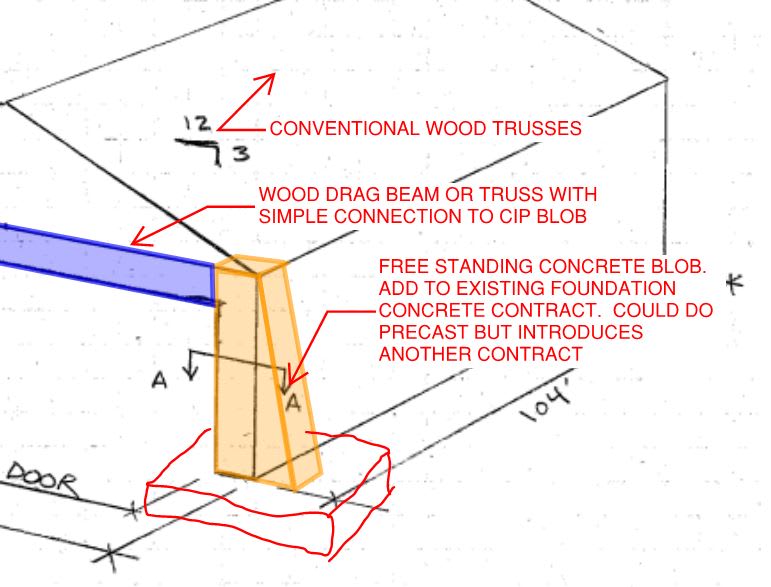Question for post frame designers:
When reinforcing a post frame end wall with plywood/OSB sheathing, can you use values from Table 4.3A Nominal Unit Shear Capacities in AWC's SDPWS 2015?
Please see attached sketch. I'm working on a preliminary design for a large building that will require some reinforcing with OSB/plyood. Due to the large 16'x70' bi-fold door, I'm left with just 5' wall segments each side of the opening for resisting lateral loads from wind. Using the ASCE 7-10 wind design criteria (115 mph, GCpi +/- 0.55, Risk Category C, etc.) and ASD load case 0.6D + 0.6W, I get unit shear of approx. 400 plf. This far exceeds the capacity of the exterior steel cladding (approx. 130 plf), but well within the capacity of 15/32" or 19/32" sheathing with a 4" or 6" edge fastener spacing. (Be sure to apply the 2.0 FS to the values in Table 4.3A). Perhaps there are some additional capacity reductions that are appropriate, considering the sheathing will be fastened to the flat face of wall girts, rather than edge of studs. But I'm thinking of doubling up the sheathing for a little peace of mind.
I'm studied the NFBA Post Frame Manual but it does not go into alot of detail on this topic. Is anyone aware of other publications that would do?
Any advice is appreciated!
When reinforcing a post frame end wall with plywood/OSB sheathing, can you use values from Table 4.3A Nominal Unit Shear Capacities in AWC's SDPWS 2015?
Please see attached sketch. I'm working on a preliminary design for a large building that will require some reinforcing with OSB/plyood. Due to the large 16'x70' bi-fold door, I'm left with just 5' wall segments each side of the opening for resisting lateral loads from wind. Using the ASCE 7-10 wind design criteria (115 mph, GCpi +/- 0.55, Risk Category C, etc.) and ASD load case 0.6D + 0.6W, I get unit shear of approx. 400 plf. This far exceeds the capacity of the exterior steel cladding (approx. 130 plf), but well within the capacity of 15/32" or 19/32" sheathing with a 4" or 6" edge fastener spacing. (Be sure to apply the 2.0 FS to the values in Table 4.3A). Perhaps there are some additional capacity reductions that are appropriate, considering the sheathing will be fastened to the flat face of wall girts, rather than edge of studs. But I'm thinking of doubling up the sheathing for a little peace of mind.
I'm studied the NFBA Post Frame Manual but it does not go into alot of detail on this topic. Is anyone aware of other publications that would do?
Any advice is appreciated!

